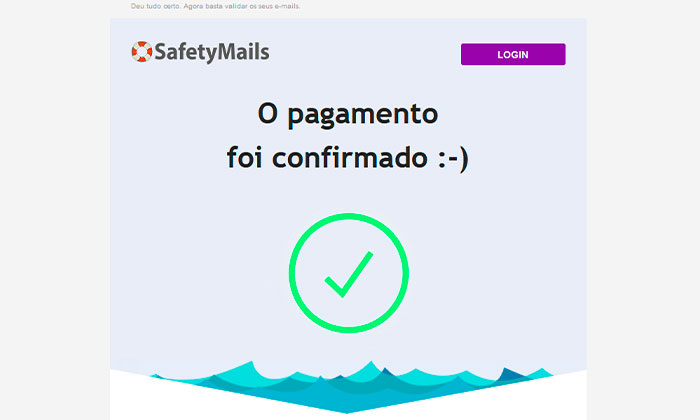What are the different types of email marketing?
Email marketing is not just about sales. If all your emails do is beg recipients to buy something, you will soon lose relevance and see your results decline. So, what other types of emails can you adopt for your marketing strategies?
We will talk about some of the different types of email marketing you can explore.
Despite turning fifty in 2021, email is still a current and very versatile tool. That fact is indisputable. And it continues to be a very popular in marketing, because of the many advantages it offers. However, thinking about and planning email marketing campaigns can be challenging.
Competition for space and attention in inboxes is increasing, and creativity and data-driven strategies are more important than ever.
As a result, companies need to exploit the range of possibilities email marketing offers on different fronts.
There are some types of emails you can include in your email relationship strategies. We can group these emails into four main categories: promotional, transactional, sales, and content emails. In addition to these, we’ll take a quick look at prospecting emails (or cold emails).
Content you will read in this article:
- Promotional emails
- Transactional emails
- Welcome emails
- Purchase confirmation
- Shipping updates
- Other transactions
- Sales emails
- Content emails
- Prospecting emails
You can watch this content on SafetyMails email verifier channel on Youtube
SafetyMails is one of the leading email verifier platforms. Consider using SafetyMails as your email checker.
Promotional emails
Contrary to what you might imagine when we talk about promotional emails, these are not limited to sales promotions: discounts, loyalty programs, etc.
The category of promotional emails includes all emails whose purpose is to promote something.
For example, when you send an email targeting inactive leads, you are promoting their reactivation. Emails that invite the user to a webinar are promoting engagement with the webinar’s content.
When you get an email from Linkedin saying that a certain number of people have viewed your profile, it’s easy to confuse this with a Linkedin Premium sales email. But that isn’t the case. In fact, this email is promotional and is designed to maintain the platform’s audience and engagement levels. A sales motivation does exist, but it comes after that; in other words, it is a secondary objective of that email.

Emails that remind you of items in your shopping cart can also be considered promotional, because their goal is to reactivate the purchasing process.
Of course, the promotional category also includes the classic emails offering discounts, coupons, early bird and seasonal specials.
Transactional emails
Any and all emails sent to inform or confirm any type of transaction, such as account creation, password recovery, purchase or registration confirmation, product delivery updates, termination notices, among others, are considered transactional emails.
According to some email marketing experts, this type of message should not be considered email marketing. However, as the main objective of these messages is almost always to strengthen the customer or subscriber relationship and promote a better user experience, they have clear marketing characteristics.
Furthermore, the design of these emails, the layout of the elements, is the same as in classic email marketing.
Transactional emails are vital components of the email marketing cycle, as for the most part they are just-in-time emails with the highest likelihood of being opened by the recipient. They play an important role in improving reputation, branding, engagement and deliverability.
Welcome emails
Welcome emails have also a very high opening rate. They are emails sent when the user creates an account or subscribes to an information service and, as such, the user expects to receive them.

To further enhance the user relationship, you can take the opportunity to send not just login and password information, but also additional content for the onboarding of this new user, such as links to manuals, tutorial videos, etc.
Purchase confirmation
Here we have the holy grail of email marketing. After all, you are sending an email to someone who, in addition to registering, has just made a purchase. It may not be the first purchase, but every purchase must be celebrated.
For the customer to feel secure and well-informed, the purchase confirmation email must be clear and transparent. Send as much information as possible to your customer, such as a list of the products or services purchased, their price, the payment method selected and expected delivery date.

In many cases, you can consider sending further information along with the e-mail, such as links to user manuals, invoices, instructional videos and product care, etc.
Shipping updates
After confirming their transaction, customers are eager to receive and enjoy their purchases. Therefore, the shipping period can be stressful, especially if the product needs to go through some kind of manufacturing process before shipping.
One way to reduce this anxiety is to keep the customer informed about each small step in the process, from production, separation from stock, packaging, shipping, delivery progress and confirmation.
Post-delivery emails also present interesting opportunities. A few days after delivery is confirmed, an email is sent asking the customer to give a review of the product and submit a testimonial for the website.
Other transactions
Take advantage of any opportunity to enhance your relationship with your customer. Registration updates, user preferences, even requests to unsubscribe or cancel purchases must be confirmed to avoid misunderstandings and maintain a good client relationship.
Sales emails
Most professionals will agree that when it comes to email marketing, the first image that comes to mind is a sales email.
Yes, the sales email is a classic digital marketing strategy, but that doesn’t mean it can’t play other important roles as well.
For example, sales emails designed to function as shopping vehicles for a range of options on display only tend to work for products with lower added value, since, as consumers, we are not equipped to deal with choice. We end up choosing the easiest option, a decision that is usually based on price.
Because of this, sales email need a strategy. Highlighting a main product for sale along with other, less prominent options helps guide the user’s buying behavior.
It’s like the special of the day in a restaurant: Although the entire menu is available for consumption, certain items are suggested to facilitate the decision process.
Another important aspect to take into account is consultative sales. Emails that deliver informative and educational content along with sales increase your chances of a higher sales ticket.
Just be sure not to overdo the frequency of sales emails. If your emails are not part of a larger and more complete communications effort, they will lose relevance and your sales and reputation will suffer. Use common sense.
Also, beware of repeat offers. For example, if a consumer buys, say, a refrigerator, you can assume he won’t buy another refrigerator for a while. Repeating this offer will not add to the end consumer experience at all. Investing in complementary products, however, can be a good strategy. After all, someone who buys a refrigerator may just be replacing old or faulty equipment, but they may also be renovating their entire kitchen, which opens up many sales possibilities.
Content emails
Newsletters are original or curated content that is emailed periodically.
They are designed to forge a relationship with, engage and educate the email base.
Newsletters are experiencing a market comeback. The reasons for this include the benefit of knowing exactly who you’re talking to and who you’re reaching (as opposed to social media), as well as the metrics available, which help track real-time performance of this tool.
To give you an idea of how important newsletters are for businesses across the world, Substack, a newsletter platform, received an investment of fifteen million dollars. The Morning Brew newsletter has been valued at seventy-five million dollars. Forbes launched its own newsletter platform, with Facebook soon to follow.
Three factors are important for maintaining good newsletter results:
#1 Relevance: The content of your newsletters needs to be relevant to the audience receiving your emails. Otherwise, your open rate will be lower and lower. Take the time to research your audience.
#2 Frequency: As with everything else, common sense is key. If you have enough content to send a daily newsletter, then do so, as long as your audience expects to receive it this often. However, you should also avoid long gaps between publications. This can cause your list to lose interest in your content.
#3 Purpose:The content of your newsletters must serve a purpose, which is to inform with relevant content. It must also further your business goals by educating your base and helping subscribers navigate content and sales channels.
Articles for educating and maintaining a relationship with your base
Here the focus is more of a business approach. Sending emails with content aimed at educating your contact base at different stages in the sales process helps advance leads and encourages conversions.
For example, sending periodic emails to customers demonstrating new features of a system, or tips for using software and applications that provide productivity gains, helps reduce the pressure on support teams and shields your customer base from competitors.
For consumer products, sending content that demonstrates the benefits of using or consuming better versions of those same products helps increase the average sales ticket. This is true of any product, whether wine, sporting goods or tires.

Content emails also help build awareness of your business among subscribers who are not current customers and can encourage them to buy or subscribe to your product or service.
Prospecting emails
Finally, I’d like to talk about a very special category of emails: prospecting emails.
Usually, this type of email is sent to recipients who are responsible for or influence service contracting or product purchasing at companies, or other specialized professionals.
For these emails, actual copy is more important than layout, since most look like messages sent through your email program.
The goal here is to gain the recipient’s attention and get them to access your website or schedule an online demo meeting.
This is done through a writing strategy that takes into account the need to address “headaches” in a particular area. Most such emails get the recipient’s attention with a direct approach and, eventually, a direct invitation as well.
Prospecting emails do not work alone; instead, they usually involve 4 or 5 contact attempts that include a first approach (where the sender seeks to introduce himself, present the business and solution he has to offer), follow up (where the objective is to seek confirmation of the attention sought in the first email), authority emails (where the sender focuses on well-known customers and market strength), and finalization (where the sender acknowledges that it may not have been the best time to approach and will seek to resume contact at another time).
These are some of the types of emails you can use in email marketing. Remember that authorization is essential and, above all, you must respect the recipient’s preferences at all times in your relationship. See how email marketing is so much more than just sending sales emails? I hope this content has helped open your mind to new email communication ideas.
What about you? Do you use other types of emails in your day-to-day?
Do you need an email checker? SafetyMails can help you!
SafetyMails is one of the leading email verifier platforms. Consider using SafetyMails as your email checker.
Create an account now and receive 100 free credits to test. Also, take a test run of the API for real-time email checker and get another 1,000 credits to test this feature.
Why is it important to implement an email verification service in your strategy?
When you build an email database, you surely want to have real people connected in your lists.
However, many people give a fake email address or an invalid one. They can simply make silly spelling mistakes during the registration process in your landing page or newsletters, for example.
SafetyMails has an expertise in prevent your whole strategy went to waste because you ended up with several addresses that are not fit to use. In other words, using our email verifier, your collected addresses are real, and can generate engagement.
In case of typos, the service can solicit corrections and reviews, making sure you don’t lose a promising lead. Everything happens in real-time and the email checker api is accurate and fast.
Would you like to know us better? Test now and check emails for free!
Choose SafetyMails email verification tool and see how easy it is to make sure no invalid or harmful addresses get to your subscriber lists!


